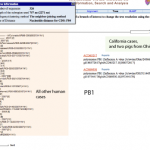viruses
Wendy Orent, having decided that Paul Ewald is the end-all and be-all of evolutionary epidemiology, is again repeating the mantra that pandemics will evolve to become less deadly. Never mind that, as ScienceBlogling Greg Laden reminds us, the first wave of the 1918 pandemic was far milder than the lethal second wave. Orent, in The LA Times:
As with any new outbreak, unraveling all of this flu's mysteries will take time. But, using the lens of Darwinian evolution, certain aspects are starting to come into focus. For one thing, it's clear that the virus, which originated in Mexico, is most…
Nick's post on Amantadine resistance in swine flu was so interesting, I had to look at the protein structures myself.
I couldn't find any structures with the S31N mutation that Nick discussed, but I did find some structures with the M2 protein and Amantadine. Not only are these structures beautiful, but you can look at them and see how the protein works and how the drug prevents the protein from functioning.
As Nick mentions, the M2 protein from influenza makes a channel for hydrogen ions within the viral membrane. The channel controls the pH inside the virus by opening and closing.…
No more delays! BLAST away!
Time to blast. Let's see what it means for sequences to be similar.
First, we'll plan our experiment. When I think about digital biology experiments, I organize the steps in the following way:
A. Defining the question
B. Making the data sets
C. Analyzing the data sets
D. Interpreting the results
I'm going intersperse my results with a few instructions so you can repeat the things that I've done…
For keeping the big picture in mind when it comes to influenza--as the CDC decides to proceed with seasonal influenza vaccine production:
Dr. Marc Lipsitch, a Harvard School of Public Health epidemiologist, said the decision to proceed with seasonal flu vaccine production is evidence "that garden-variety seasonal flu kills on the order of 36,000 people a year, and while we are in a crisis and it might seem to make sense to ignore that, you can't."
..."We want to make sure in the vaccine manufacturing that we were still able to protect the country from seasonal flu and be able to protect from…
We had a great discussion in the comments yesterday after I published my NJ trees from some of the flu sequences.
If I list all the wonderful pieces of advice that readers shared, I wouldn't have any time to do the searches, but there are a few that I want to mention before getting down to work and posting my BLAST results.
Here were some of the great suggestions and pieces of advice;
1. Do a BLAST search. Right! I can't believe I didn't do that first thing, I think the trees I got surprised me so much all sense flew out of my brain.
2. Show us the multiple alignments. Okay. I'll…
...Oh my? The CDC is being very smart about this issue. As long time readers of this blog will know, the Mad Biologist is very concerned about the evolution of resistance to antibacterials (antibiotics) and antivirals. One such antiviral is Tamiflu which is used to treat influenza infections.
The CDC has flown in experts on the evolution of antiviral resistance to advise them on when and how Tamiflu should be used, so as to limit the evolution of resistance to Tamiflu.
And the CDC seems to be listening. You might have noticed that there has been very little public discussion of Tamiflu--…
I'm teaching an on-line bioinformatics course this semester for Austin Community College. They are in Texas of course, but I am in Seattle. This presents a few interesting challenges and some minor moments of amusement.
Today, the school sent all the faculty emails telling us to stay home if we're sick.
Got it. If I think I have flu, I will not fly to Texas.
Instead, I'll stay home and watch videos on coughing without contaminating others.
Watch "Why don't we do it in our sleeves?" and find out how you rank on the safe coughing scale.
Probably not. I have no idea how serious this swine flu outbreak will be. As I noted yesterday, it could evolve to cause less severe symptoms or more severe symptoms--right now, nobody knows for certain. But I find the possible overreaction by the public to be disturbing (I think the public health system has adopted the right tone--and kudos, in part, to Richard Besser. Gerbeding who?). Why?
Every year, roughly 36,000 people die from seasonal (or annual influenza). That's double HIV/AIDS deaths. But nobody gets paranoid about handwashing (WASH YOUR DAMN HANDS!!). There's no serious…
HIV is an elusive adversary. The virus is so good at fooling the immune system that the quest for an HIV vaccine, or even a countermeasure to resist infections, has spanned two fruitless decades. But maybe a defence has been lurking in our genomes all this time.
Nitya Venkataraman from the University of Central Florida has managed to reawaken a guardian gene that has been lying dormant in our genomes for 7 million years. These genes, known as retrocyclins, protect monkeys from HIV-like viruses. The hope is that by rousing them from their slumber, they could do the same for us. The technique…
This afternoon, I was working on educational activities and suddenly realized that the H1N1 strain that caused the California outbreak might be the same strain that caused an outbreak in 2007 at an Ohio country fair.
UPDATE: I'm not so certain anymore that the strains are the same. I'm doing some work with nucleic acid sequences to look further at similarity.
Here's the data.
Once I realized that the genome sequences from the H1N1 swine flu were in the NCBI's virus genome resources database, I had to take a look.
And, like eating potato chips, making phylogenetic trees is a little bit…
Since TEH SWINE FLU!!!11!!! is a hot topic, I thought this post about how infections could evolve increased virulence after switching animal hosts was relevant. From the Murky Depths of the Mad Biologist's Archives: There's no reason to think that an epidemic influenza strain won't become more deadly....
Several people have argued that if an influenza pandemic were to occur, it will rapidly evolve to become less virulent--that is less deadly. A recent paper explains why this might be wrong.
Basically, the flaw with the 'optimistic' argument is that it is assumes that the virus will be…
That's how new life forms are created every day in the wild, folks. Human researchers of course have added a few twists on the theme. If we can't induce bacteria or animal cells to collect new bits of DNA on their own, we turn to electroshock therapy. With plants.... aw heck, we just shoot them.
And where did this crazy rant come from you ask? Last Saturday morning, at the crack of 9 am I got to be interviewed on a radio program with two of the main spokespeople from the DIY bio movement, Mackenzie Cowell and Meredith Patterson.
The program was "The Food Chain" (you can listen to it…
If you haven't seen these, check out Jake Young's collection of videos showing T cells getting infected by HIV. The best one is at the bottom of the post.
The world of genetics is filled with stories that are as gripping as the plot of any thriller. Take the IRGM gene - its saga, played out over millions of years, has all the makings of a classic drama. Act One: setting the scene. By duplicating and diverging, this gene thrived in the cells of most mammals as a trinity of related versions that played vital roles in the immune system.
Act Two: tragedy strikes. About 50 million years ago, in the ancestors of today's apes and monkeys, the entire IRGM cluster was practically deleted, leaving behind a sole survivor. Things took a turn for the worse…
When people say that every cloud has a silver lining, they probably aren't thinking about herpes at the time. Herpes may be unpleasant, but the viruses that cause it and related diseases could have a bright side. In mice at least, they provide resistance against bacteria, including the bubonic plague.
Herpes is one of a number of itchy, blistering diseases, caused by the group of viruses aptly-named herpesviruses. Eight members infect humans and cause a range of illnesses including glandular fever, chickenpox, shingles and, of course, herpes itself.
Almost everyone gets infected by one of…
This is the eighth of eight posts on evolutionary research to celebrate Darwin's bicentennial.
In Virginia, USA, sits a facility called the American Type Culture Collection. Within its four walls lie hundreds of freezers containing a variety of frozen biological samples and among these, are 99 strains of the common cold. These 99 samples represent all the known strains of the human rhinoviruses that cause colds. And all of their genomes have just been laid bare.
Ann Palmenberg from the University of Wisconsin and David Spiro from the J. Craig Venter Institute have cracked the genomes of all…
This is the seventh of eight posts on evolutionary research to celebrate Darwin's bicentennial. It combines many of my favourite topics - symbiosis, horizontal gene transfer, parasitic wasps and viruses.
Parasitic wasps make a living by snatching the bodies of other insects and using them as living incubators for their grubs. Some species target caterpillars, and subdue them with a biological weapon. They inject the victim with "virus-like particles" called polydnaviruses (PDVs), which weaken its immune system and leave the wasp grub to develop unopposed. Without the infection, the wasp egg…
Before I get to the ongoing calamity, the economic impact of a nation-wide viral epidemic in horses in 1872 is worth considering (italics mine):
During the late 19th century, the American economy relied on horses the way it depends on gas today. Horses unloaded cargo from ports, transported goods from city to city, worked the farms, supported the army, and served as the emergency vehicles of choice. Without them, the American workforce would have ground to a halt.
And that's exactly what happened in 1872, when an estimated 99 percent of all horses in America contracted equine influenza. The…
Ebola virus has impressed me as creepy ever since I read "The Hot Zone: A Terrifying True Story some years back by Richard Preston. (I guess he has a new book, too, Panic in Level 4: Cannibals, Killer Viruses, and Other Journeys to the Edge of Science but I haven't been in airport for the past couple of weeks, so I haven't read it yet.)
Technorati Tags: blast, phylogenetic trees, Ebola, viruses
Infectious agents that cause diseases with gruesome symptoms really excite those of us with an interest in microbiology. Tara has written about this paper, too, and summarized the details.
I…
If you're going to create a new life form (even if it's only digital), Sunday Saturday seems like the best day to give it a try.
Reposted from an earlier year.
Build-A-Virus is a quick, fun, and simple game that was created and put on-line by Bioreliance, now owned by Invitrogen. This game is lots of fun, even when your students are college instructors.
In this activity, you create a new virus by picking different physical characteristics.
The game works like this:
First, you choose whether the virus has an envelope or not.
Next, you choose whether the genome is single or double-…

